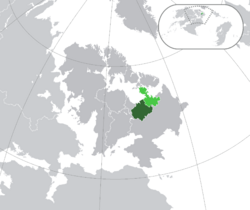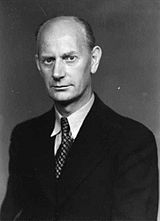West Ruthen
This article is incomplete because it is pending further input from participants, or it is a work-in-progress by one author. Please comment on this article's talk page to share your input, comments and questions. Note: To contribute to this article, you may need to seek help from the author(s) of this page. |
People's Republic of Ruthen Volksrepublik Ruthen (Ruthish) | |
|---|---|
| Motto: Arbeiter aller Länder, vereinigt Euch! | |
| Anthem: "Thessin" | |
 Territory controlled | |
| Capital and largest city | Thessen |
| Official languages | Ruthish Hyacinthean |
| Ethnic groups (2020) | 83.5% Ruthish 16.5% other |
| Religion (2020) | 52.8% Gregorianism 40.3% Irreligious 6.9% Others |
| Demonym(s) | West Ruthish · Ruthish |
| Government | Federal Arvidsenist socialist republic |
| Gunnar Schönau | |
| Tilmann Rosenblatt | |
| Otto Thoma | |
| Natali Mannheim | |
| Legislature | National Political Council |
| Establishment | |
| 9 December 987 | |
| 9 September 1438 | |
| 27 February 1862 | |
| 28 November 1864 | |
| 14 July 1943 | |
| 13 August 1945 | |
| 30 October 1977 | |
| Area | |
• Total | 206,291 km2 (79,649 sq mi) |
• Water (%) | 1.0 |
| Population | |
• 2023 estimate | |
• 2020 census | |
• Density | 321.79/km2 (833.4/sq mi) |
| GDP (PPP) | 2020 estimate |
• Total | |
• Per capita | |
| GDP (nominal) | 2020 estimate |
• Total | |
• Per capita | |
| Gini (2020) | low |
| HDI (2022) | very high |
| Currency | Ruthische Mark (ʀ) (WRM) |
| Time zone | UTC+0 (Central Calesian Time, CCT) |
• Summer (DST) | UTC+1 (Central Calesian Summer Time, CCST) |
| Date format | dd-mm-yy |
| Driving side | left |
| Calling code | +25 |
| Internet TLD | .vr |
West Ruthen (Ruthish: West-Ruthen), officially the People's Republic of Ruthen (PRR; Ruthish: Volksrepublik Ruthen: VRR), is a sovereign country in Central Calesia. The country's northern border is defined by its coastline with the Swarin Sea as well as Dutchland. To the east it shares a border with East Ruthen along the Ruthish Demilitarised Zone although it claims sovereignty over the entirety of East Ruthen. It shares several borders with other states in the south. In the west it borders Hyacinthe and Dahemia. West Ruthen claims to be the sole legitimate Ruthish government. It has a population of 65.46 million people and a total land area of 206,291 km2 (79,649 sq mi), making it the third-largest and third-most populous country in Calesia. The capital and largest city of West Ruthen is Thessen which lies in the Lonane Arc conurbation; other significant major urban areas include Schwechat, Hallschlag, Höhn, Ratekau and Lüchow.
The area encompassing greater Ruthen has been inhabited since the Paleolithic era and from the Neolithic era by various Celts and later Waldic tribes in the north of the country. The area to the south of the Hunsrück river which today forms the boundary between East and West Ruthen fell under the control of the Hernician Empire who first named the area Maior Ruthenia. After the fall of the Hernician Empire by tribes such as the Ruthenii, various Waldic states emerged before eventually being united into the first North Ruthenic Kingdom. Ruthen enjoyed a period of relative stability until the Catabolic Crisis which saw the collapse of the North Ruthenic Kingdom in 1355. The subsequent Ninety Years' War and the Peace of Sallahn led to the creation of the Ruthish Confederation which saw Ruthen re-emerge as a major power in North Central Calesia albeit as a loose confederation of several dozen independent states. During the !Reformation, the Ruthish Confederation was divided on religious lines with the northern and coastal regions falling under the influence of states loyal to the Northern Cathedralist Church whilst states more central in the Confederation remained loyal to the Presterist church.
The Renaissance in the 17th century allowed for the development of liberal and pan-Ruthenic thought, advancements in technology and communication also allowed these ideas to spread more rapidly throughout the Confederation. The Twelve Years' War and Elizabeth Square Declaration in Falland were the catalysts for events in Ruthen as liberal bourgeois revolutionaries were able to seize swathes of territory. The Thessen Parliament in February 1862 saw the first Ruthish Constitution adopted by Radical and Liberal politicians and the establishment of the constitutional Kingdom of Ruthen in 1864 after the War of Ruthish Unification. Ruthen was a key colonial power during the late 19th century, openly pursuing the creation and expansion of overseas colonial holdings culminating in the establishment of one of the largest Calesian empires at the time. In the late 19th and early 20th centuries, Ruthen became deeply politically divided between the emerging socialist parties and the governing liberal parties which sparked the Roter Sommer in 1923.
During the Great War, Ruthen was a core member of the Sydenham Powers and mainly fought in its overseas territories with the aim of seizing Waldish colonies. The war's unpopularity at home combined with significant socialist civil unrest and the failure of peace talks saw the Ruthish government collapse and a new emergency interim government was established which created the short lived Ruthish Republic prior to surrendering to the Transmedan Powers. The post-war Joint Occupation Authority in Ruthen of the period of Transmedan occupation collapsed during the 1944 Ruthish Crisis which saw the installation of a socialist government in Ruthen and Declaration of the Ruthish Republic. The People's Republic of Ruthen was established shortly afterwards on 13 August 1945 and initially enjoyed far more political and diplomatic legitimacy as the official sole Ruthish state. In July 1999, after a period of worsening relations, West Ruthen invaded East Ruthen, sparking the Six-Day War and the establishment of the Ruthish Demilitarised Zone and the United Congress Monitoring Authority for Ruthen (UCMAR); no formal peace treaty has ever been signed.
West Ruthen is a federal socialist republic with an indirectly elected legislature and government in accordance to the 1977 constitution and since the turn of the millennium has experienced a period of general political stability and economic development. West Ruthen has one of the world's highest scores of the Human Development Index with high levels of income equality and a robust welfare state and economy dominated by co-operative industries; it is the world's ninth-largest economy. It has been a member state of the United Congress since 2001 as part of the Inter-Ruthish peace process. West Ruthen enjoys close ties to the socialist and developing world and is one of the largest providers of foreign aid to developing countries; it is a member state of the Global Socialist League.
Etymology
History
Prehistory
Hernician era
North Ruthenic Kingdom
Ninety Years' War
Ruthish Confederation
Reformation
Emergence of nationalism
Kingdom of Ruthen
Ruthish colonial empire
Great War and occupation of Ruthen
Establishment of the People's Republic
Gmehling Era
Mahlau Era
Grenzpolitik
Six-Day War
Contemporary history

Geography
Climate
Biodiversity
Government and politics
West Ruthen is a federal Arvidsenist non-partisan socialist republic according to the Constitution of West Ruthen. Legally, West Ruthen operates under a directorial system with the simultaneous head of state and head of government being members of the Executive Council. The President is elected from members of the Executive Council for a once renewable five year term, although the position is legally a figurehead, they hold considerable influence on West Ruthish political affairs. The Executive Council also nominates a Vice-President, usually the runner-up for the nomination for President, who serves as the deputy for the President and can become acting President if the President is incapacitated or unable to fulfill their duties. The Executive Council can remove a President if three-quarters of its members issue a motion of no-confidence which would trigger a special election amongst the Executive Council for a caretaker replacement to serve the remainder of the former President's term.
The Executive Council exists as the de facto cabinet of West Ruthen with each member having responsibilities over differing areas of the government. As of 2024, there are 40 members on the Executive Council. The Council is chosen every five years by the National Political Council and its members do not have a term limit unlike the Presidency. A candidate for the Executive Council requires three-fifths support from the Political Council to be elected; due to this and the number of candidates each year, there can be several rounds of voting by the Political Council until a nominee is selected. The Executive Council chooses from amongst themselves who will be President and Vice-President, elections to these positions can often take several rounds of voting as a candidate requires two-thirds support or a supermajority from the Executive Council to be elected. If a member of the council vacates their position, the Political Council is tasked with choosing a successor. The Executive Council has the ability to veto laws as a collective if three-fifths of its members oppose a law; a veto needs three-quarters of all members of the Political Council to vote in favour of removing the veto in which case the bill automatically becomes law.
The National Political Council is the legislature of West Ruthen and is tasked with drafting and voting on laws, electing members of the Executive Council, possessing the power of impeachment, and holding them accountable as well as representing their differing constituent groups. The National Political Council is constitutionally a non-partisan system as political parties are recognised as anti-constitutional, however various factions have been formed from ideologically likeminded members of the Executive and Political councils. The Political Council does not have nationwide elections for the vast majority of its members, instead its members are chosen by members of local, workplace, trade union, social and regional committees which themselves are elected by voters, citizens and workers. However, 100 of the Political Council's 700 members are elected nationally every two and a half years.
On the lowest level of government, all Ruthish workers are able to elect workplace councils, local councils and regional councils which operate on similar lines to the national government. Members of workplace councils are divided into several differing sectors depending on the type of jobs they are which are represented by various independent trade unions. The trade unions themselves independently elect 175 members to the NPC whilst the All Ruthen Trade Union Federation elects a further 175 members. Regional governments which are elected by all voters over the age of 16 also have the power to elect a further 200 members of the National Political Council. 50 seats in the Political Council are reserved for members of various social groups such as the National Cultural Federation, All-Ruthish Federation of Sports and Activity, Federation of Ruthish Young Pioneers, National Women's Union of Ruthen and the Land Union, amongst others.









